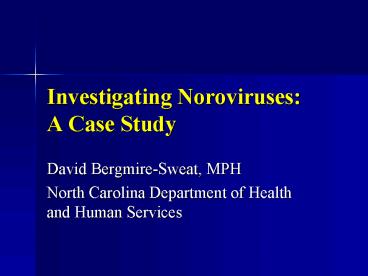Investigating Noroviruses: A Case Study PowerPoint PPT Presentation
1 / 21
Title: Investigating Noroviruses: A Case Study
1
Investigating Noroviruses A Case Study
- David Bergmire-Sweat, MPH
- North Carolina Department of Health and Human
Services
2
Norovirus Facts
- Small, round-structured viruses from
Caliciviridae family - First recognized as pathogenic cause of
gastroenteritis in 1968, Norwalk, Ohio - Transmitted via fecal-oral route
- Highly contagiousas few as 10 viral particles
can cause infection
3
Symptoms
- Incubation period 24-48 hours, can be less
- Vomiting
- Watery non-bloody diarrhea
- Abdominal cramps
- Nausea
- Low-grade fever
- Symptoms typically resolve 24-60 hours (1-3
days)
4
Documented Modes of Transmission
- Foodhandler contamination of items in restaurant
- Daycare centers
- Secondary person-to-person
- Aerosolized (vomiting and diarrhea)
- Cleaning up after ill person in a bathroom
5
Immunity Epidemiology
- Seems to be strain-specific and temporary (few
months) - CDC estimates 23 million cases of acute
gastroenteritis annually in U.S. due to
noroviruses - CDC estimates noroviruses cause 50 of all
foodborne disease outbreaks
6
Detection
- Best method is via reverse transcriptase
polymerase chain reaction (RT-PCR) - Viral RNA
- Adults can shed viral particles for up to 2 weeks
after symptoms resolve - Infants and toddlers may shed longer
7
Case Study
- Small state university north of Houston, TX
- Student body 10,000 students
- 2,054 students owned meal plans
- 125 students present to student health center and
local hospital with gastrointenteritis in 24 hr
period
8
Symptoms
- 125 ill students on March 10-11 1998
- 23 admitted to hospital
- 91 reported vomiting
- 85 reported diarrhea (3 loose stools in 24
hours) - 68 reported abdominal cramps
9
Epidemic Curve
Cases by Onset Date
10
Laboratory Investigation
- 62 stool samples sent to Texas Department of
Health Lab in Austin - All negative for Salmonella, Shigella,
Campylobacter, Yersinia, E. coli O157H7,
Bacillus cereus, and Staphylococcus aureus - 18 samples tested for Norovirus by RT-PCR 9 were
positive
11
Challenges of Cafeteria Outbreaks
- Verifying Exposures
- Identifying potential healthy controls
- Finding people to interview them
- Hundreds of food items
- Rule in/out other exposures
12
Rapid Action
- Outbreak occurred toward end of week, right
before Spring Break - Sanitarians from local health department
investigated, realized cafeteria was about to
close for week and perform massive
cleaning/maintenance - Locked down all present food items, instructed
staff not to throw anything out
13
Epidemiologic Investigation
- Unmatched Case-control study by Texas Dept. of
Health - 36 ill subjects
- 136 well controls
- Matched Case-control study by CDC
- 29 ill subjects
- 29 well controls
14
Findings Matched Study
15
Findings Unmatched Study
16
Interpretation
- Both studies implicated deli sandwiches on 3/9
and 3/10 - The more controls in a study, the better
statistical power you have - No other restaurants or food items showed any
association
17
Cafeteria Staff Investigation
- Sanitarians and epidemiologists interviewed
foodhandlers - All denied illness
- All except one submitted stool samples for
testing - One refused cafeteria manager fired her
- She was responsible for slicing deli meats and
making deli sandwiches
18
Discussion
- CDC and TDH epidemiologists were disappointed
with cafeteria manager decision to fire the one
employee - Much more difficult to get cooperation
- Eventually did interview her
- She denied illness, but had infant with diarrhea
- Stool sample from infant was PCR positive for
Norovirus
19
Chance to Learn Something
- Researchers at Baylor College of Medicine agreed
to try to find virus RNA on deli meat - Never been done before
20
Success!
- Lab successful in designing protocol for
recovering virus RNA from deli meat - Pulsed-Field Gel analysis of PCR results showed
identical pattern between infant, ill students,
and deli meats
21
Take Home Points
- Viral gastroenteritis is easy to spread
- Foodhandlers must be extremely careful, even when
they are not sick, with hygiene - It is possible to recover Norovirus from food
- Quick reaction by local health department
sanitarians preserved food samples - Collaboration with research lab advanced science
of food safety research

